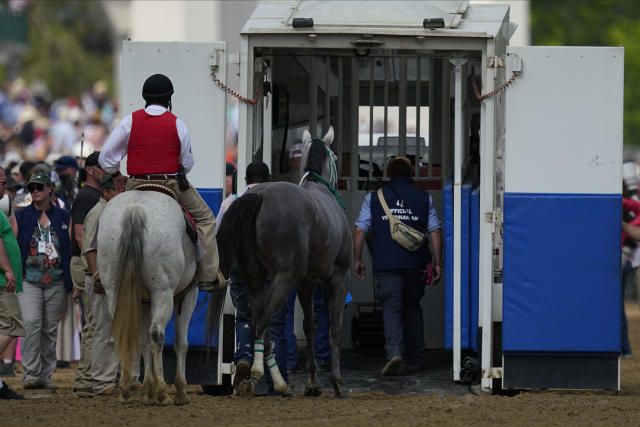
As Churchill Downs prepares to host the 150th Kentucky Derby on Saturday a darker anniversary looms. One year ago, 12 horses died at Churchill Downs in the days and weeks surrounding America’s biggest race.
As hype builds around this year’s runners, those who died fall deeper into the well of memory, if they’re thought of at all. Wild on Ice, a gelding born in 2020 and a Derby qualifier, was euthanized after sustaining a hind leg fracture during training leading up to last year’s race. His connections expressed regret over their missed opportunity to watch him reach his full potential. A month later, Kimberley Dream, a seven-year-old “war horse” was making her 61st start when she broke down in a claiming race. In the chart the final note on her short life read “went wrong in upper stretch”.
In the time between those deaths there was routine equine suffering at Churchill with the deaths of Code of Kings, Parents Pride, Take Charge Briana, Chasing Artie, Chloe’s Dream, Freezing Point, Rio Moon, Lost in Limbo, Bosque Redondo, and Swanson Lake. Twelve dead at one track in one month. Those horses were no different than the ones on the backside and the racing cards this time around. For racing fans and runners’ connections Derby Day is exciting, prestigious, and maybe even profitable but for the horses it’s about survival. When a day in the sport concludes without death there is a collective sigh of relief. What a grim reality.
Cardiovascular collapse, catastrophic leg injury, and exercise-induced sudden death are constant threats. All who died on their race day last year were reportedly deemed sound by track vets. Some connections seemed to blame the horses themselves by claiming their horse “took a bad step” resulting in a broken leg. It’s an excuse that is often used to explain away breakdowns – but it is a claim worth questioning, considering racehorses’ athleticism and overwhelming drive to protect themselves.
Then again, when a young horse is exhausted and overstressed a stumble is conceivable. Year after year, scandal swirls around the sport, and countless more racehorses across the US die violently and silently, away from the spotlight of big races like the Derby. For decades the story has been the same, only the horses and doping mechanisms have changed. If equine welfare is a reliable measure of how racing is doing, what happened around last year’s Kentucky Derby should not be ignored. The industry moves on from these events again and again; the dead cannot.
After last year’s tragedies an investigation found that the 12 horses who died at Churchill Downs had all run more frequently over the span of their careers than the average racehorse. No other correlation between them was identified. Absent a gruesome coincidence (one that has happened repeatedly at different tracks over the years) one reasonable conclusion is that these horses were simply pushed too early, too hard and too often something I routinely witnessed during my career on the track.
A long stretch of my life was spent on racehorses. Working with young horses both on, and now off, the track has given me deep insight into them. I am struck by how inherently abusive racing is to young horses. When racehorses are started or “broken” as babies they are whisked to the track to begin training preparation at the gallop. Two-year-olds are thrust into a full-blown racing career before they have time to develop balance and the physical and mental integrity necessary to carry weight safely and comfortably at maximum speed. Derby runners are technically three years old (all Jockey Club thoroughbreds share a universal 1 January birthday, but their actual birthdays are often months afterwards) but by the time they run for the roses their bodies have already taken a beating.
Leave a Reply